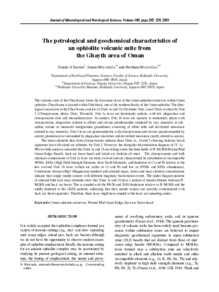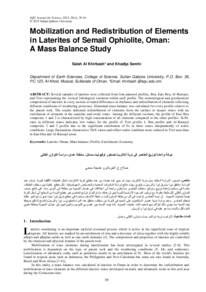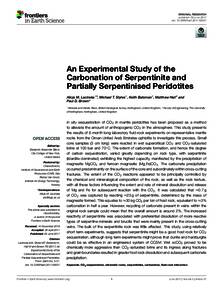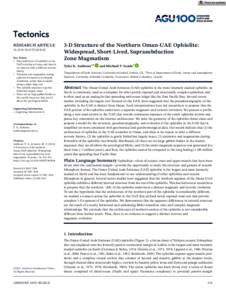Document
The petrological and geochemical characteristics of an ophiolite volcanic suite from the Ghayth area of Oman.
Identifier
DOI: 10.2465/jmps.100.202
Source
Journal of Mineralogical and Petrological Sciences. v. 100, 5, p. 202-220
Contributors
Miyashita, Sumio., Author
Matsueda, Hiroharu. , Author
Country
Japan
City
Hiroshima
Publisher
The Japanese Association of Mineralogists.
Gregorian
2005-10-01
Language
English
Subject
English abstract
The volcanic suite of the Ghayth area forms the lowermost lavas of the Oman ophiolite extrusives within Oman ophiolite. Ghayth area is located within Fizh block, one of the northern blocks of the Oman ophiolite. The lithological succession in the Ghayth area consists of Units 1a and 1b (Geotimes Unit, Lasail Unit) overlain by Unit 2 (Clinopyroxene-phyric Unit). Texturally, Unit 1a lavas are dominantly aphyric, with few plagioclase and clinopyroxene clots and microphenocrysts. In contrast, Unit 1b lavas are sparsely to moderately phyric with clinopyroxene, plagioclase (altered to albite) and olivine pseudomorphs (replaced by clay minerals) in sub-ophitic texture in intersertal-intergranular groundmass consisting of albite laths and devitrified mesostasis (altered to clay minerals). Unit 2 lavas are glomerophyritic with clinopyroxene and olivine (pseudomorphed by calcite) glomerocrysts surrounded by plagioclase microlites and devitrified mesostasis (partly altered to calcite). The minor elements data from clinopyroxenes indicate those Units 1a, 1b and 2 showing tholeiitic basalt signatures but with island arc affinities for Unit 2. However, the triangular discrimination diagram of (Y-LaNb) for bulk analyses indicated that Units 1a and 1b are falling where the three fields of N-MORB(Normal Mid Ocean Ridge Basalt), back are basin basalt and island are tholeiite all meet. The clinopyroxenes and bulk chemical compositions of Unit 1a lavas are more evolved and are characterized by enrichment of incompatible HFSEs, REEs (High Field Strength Elements, Rare Earth Elements) and depletion of Cr and Ni relative to the less evolved Unit 1b lavas (which are richer in Cr and Ni and low in HFSEs and REEs abundances). Correlations between Mg# (Magnesium number) and selected major, minor and trace element concentrations indicate their single mantle sources with different magmatic fractionation events. The spider diagram patterns of selected bulk rock trace elements show that Units 1a and 1b have a pattern of mixed affinities between N-MORB and back-are basin. This is coupled with the Nb/Ta and Zr/Hf depletions relative to N-MORB and the mildly depleted to flat LREE patterns, indicating that their mantle sources are possibly contaminated with back-arc basin signatures. Therefore, these lavas might have erupted in the back-arc spreading center.
ISSN
1345-6296
Category
Journal articles




